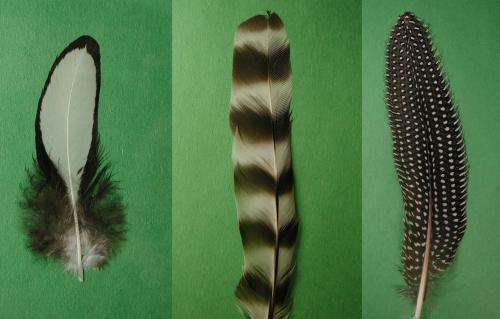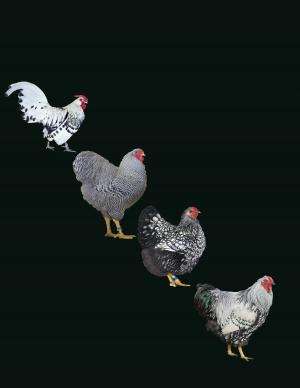April 26, 2013 report
Research sheds light on how patterns form in bird feathers

(Phys.org) —A new study by scientists in the U.S. and Taiwan has shown that birds have colorful and patterned feathers because of specific cellular interactions involving stem cells rather than through the direct involvement of encoding in DNA.
Until now the patterning of pigmentation in bird feathers has been poorly understood, but the patterns and colors are known to be important for attracting mates, protecting from predators, and they also affect bird behavior and can exhibit seasonal variations. The new study found that the complex patterns formed by the pigments in the feather follicles were the result of several distinct mechanisms, including changes in melanocyte formation.
The research team found that the first important process was the production of melanocytes, which are also found in hair, where they produce the pigment melanin. In hair, melanocyte stem cells (McSCs) are found in the follicle bulge at the base of the follicle. The new research found melanocyte progenitor stem cells in a ring in the proximal follicle, and showed that the melanocytes distribute upwards into the epithelial cylinder of the feather as it grows. The different patterns in each feather are determined by the arrangement and differentiation of pigmented and apigmented melanocytes. They found the melanocyte distribution could differ from the front to the back of the feather, and from the center to the outer edge. The patterns and colors could also change over time as the feather grew.
The research team, led by Dr. C.M. Chuong of the Keck School of Medicine at the University of Southern California and the National Taiwan University, looked at the processes involved in pigment formation in several species of birds, including chickens. They first mapped the progenitor cells in regenerating feather follicles, and found that during the growth phase the progenitors gave rise to both pigmented and apigmented melanocytes. During the resting phase the progenitor cells were quiescent.

They next transplanted melanocyte progenitor cells from adult quail feathers into chicken embryos and found that the chickens produced pigmented feathers.
The team looked at white feathers from several types of white chicken to determine whether the whiteness was caused by the absence of melanocytes or suppressed melanocyte differentiation, and they examined feathers with different colors at each end, and striped feathers, to try to determine how these patterns were formed. They found that while melanocytes may be present in apigmented regions and there were still melanocyte progenitor cells, the melanocytes were not differentiated.
The researchers also found that the patterning was affected by the topological shape of the melanocyte stem cell progenitor niche. The appearance of pigment was also affected by agouti, a peptide found in the pulp in the feather follicles. Agouti had a modifying effect on pigmentation, since it was found to inhibit melanocytes and produce unpigmented regions.
More information: Topology of Feather Melanocyte Progenitor Niche Allows Complex Pigment Patterns to Emerge, Science DOI: 10.1126/science.1230374
ABSTRACT
Color patterns of bird plumage affect animal behavior and speciation. Diverse patterns are present in different species and within the individual. Here, we study the cellular and molecular basis of feather pigment pattern formation. Melanocyte progenitors are distributed as a horizontal ring in the proximal follicle, sending melanocytes vertically up into the epithelial cylinder which gradually emerges as feathers grow. Different pigment patterns form by modulating the presence, arrangement, or differentiation of melanocytes. A layer of peripheral pulp further regulates pigmentation via patterned agouti expression. Lifetime feather cyclic regeneration resets pigment patterns for physiological needs. Thus, the evolution of stem cell niche topology allows complex pigment patterning via combinatorial co-option of simple regulatory mechanisms.
Journal information: Science
© 2013 Phys.org














